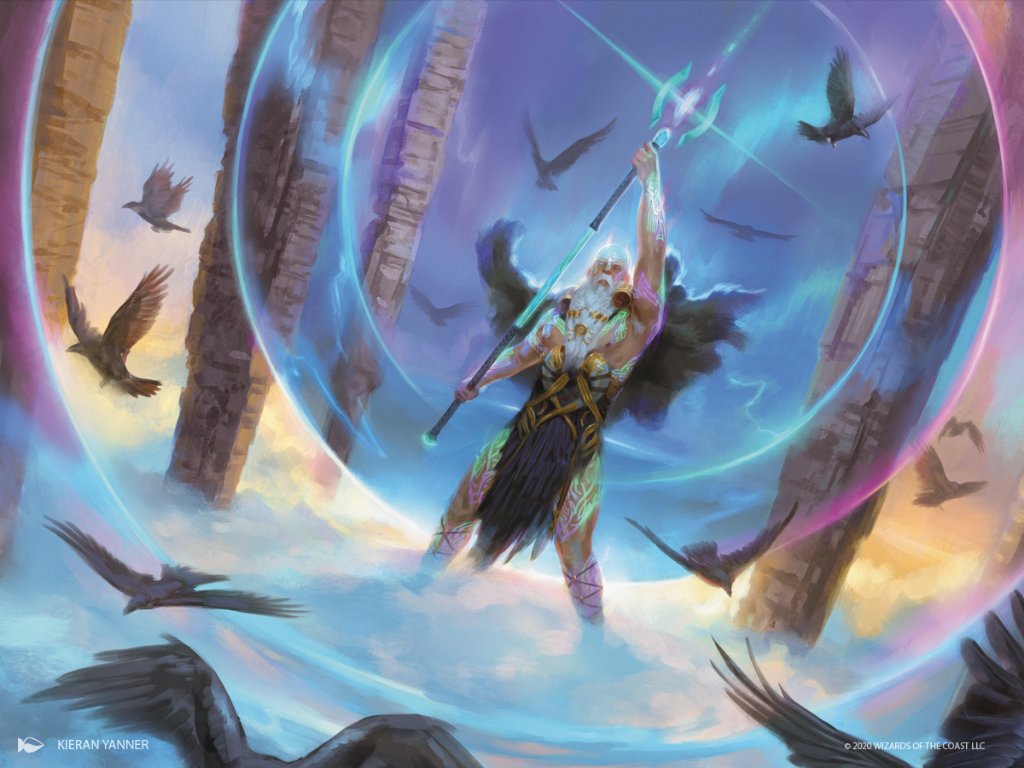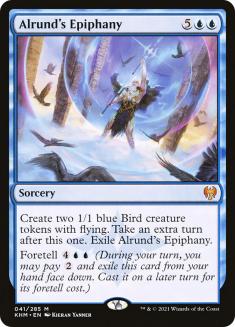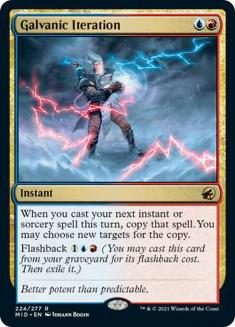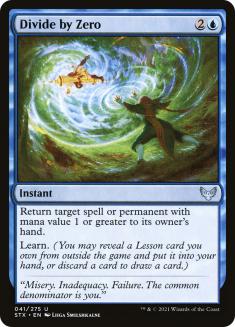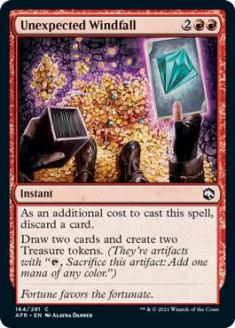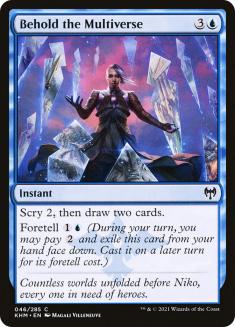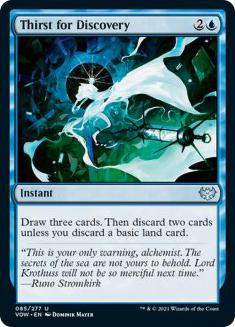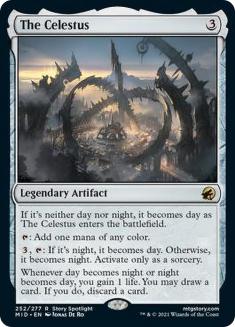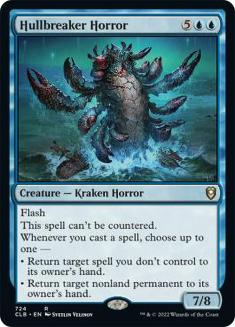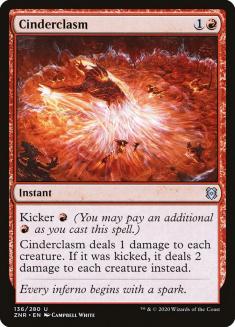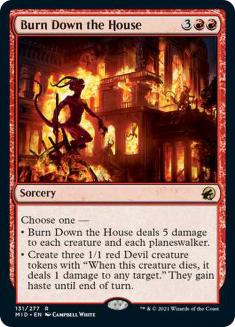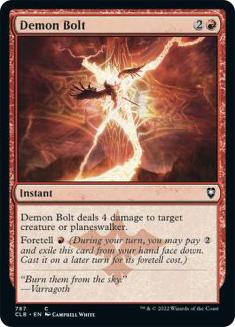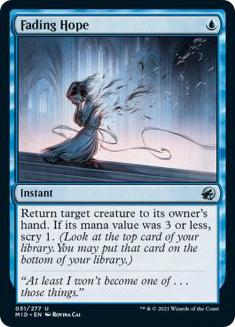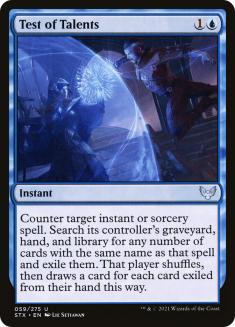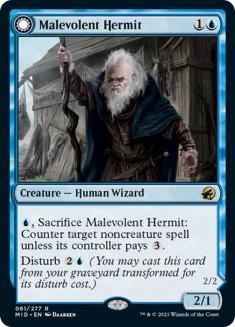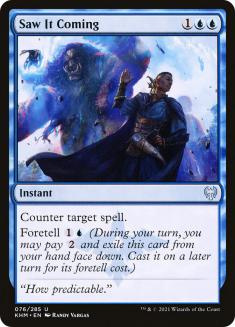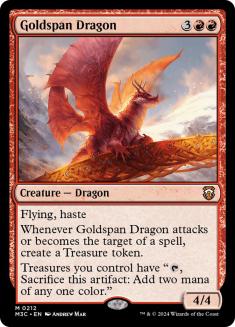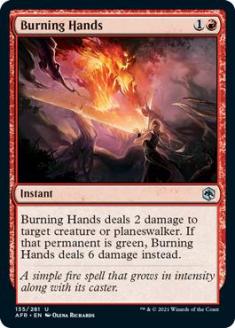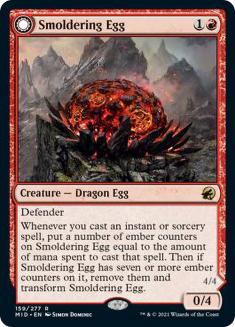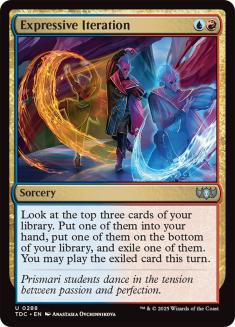By the time the Innistrad Championship came around, I think everyone expected Izzet decks to be the most popular decks in the field. What many people didn’t expect was for them to also perform the best. Most of the time, when you have a deck that’s this popular, it tends to perform around 50%, because everyone is trying to beat it. Izzet Epiphany not only surpassed my expectations in terms of popularity (I expected 35%-ish, it ended up being almost 50%) but it also had the best win rate in the format!
In this case, it wasn’t even particularly close, which means we find ourselves yet again in a situation where the most popular deck is also the best. There’s no question that Izzet Epiphany was the best deck for the Innistrad Championship, and it will very likely remain so for the rest of Innistrad: Crimson Vow Standard.
Here’s the list I played:
Lands (22)
Spells (38)

I went 5-3 in Standard, losing three Izzet mirrors (and beating two other Izzet decks), but our team did extremely well overall, including an incredible 16-4 record in the Izzet mirror (this excludes 75 card mirrors from the team, which was one of my losses). I think we really hit the nail on the head with our Epiphany deck and it’s too bad we didn’t do well at all in Historic, otherwise we’d have had a lot more people in the Top 8.
| Matchup | Wins | Losses |
| Izzet Epiphany | 16 | 4 |
| Mono-White Aggro❄ | 3 | 3 |
| Orzhov Control❄ | 2 | 0 |
| Mono-Green Aggro❄ | 3 | 1 |
| Izzet Dragons | 3 | 0 |
| Mono-Black Zombies❄ | 1 | 1 |
So, why did our list do so well? A couple of things:
- We identified that the matches versus the aggro decks were all very play/draw dependent, which meant you didn’t need to tune your deck too much to beat them. We were likely going to win on the play and were likely going to lose on the draw regardless of what the opponent did, and it wasn’t worth all the slots that it took to fix this. This meant that we could tune our deck more towards beating the mirror rather than dedicating a ton of slots for the aggro decks. There were some limits (you couldn’t just play 4 Test of Talent), but for the most part we were happy playing fewer removal spells than other people.
- We identified that the best thing to do in the mirror was just to focus 100% on assembling your combo (Alrund’s Epiphany + Galvanic Iteration). There’s simply not a lot of interaction in Game 1 in the mirrors, so you want to be goldfishing people. This means the most important cards in the deck are, in order:
Lots of people didn’t play four of those and I think that’s a mistake because you just want to assemble both.
The one interaction that you want to play, using it on your own spells comes up a lot in the mirror and you have a lot of dead cards to loot.
The best way to get ahead on mana.
Our list had four copies of the combo, but it also had two Behold the Multiverse, one Thirst for Discovery, and one The Celestus, on top of 29 other lands. This is more card drawing than almost anyone else.
Here, an important point is that there’s not a lot of interaction in Game 1s, but there could be if you wanted to. After all, there’s nothing stopping you from playing a bunch of counterspells. However, this is the one change you can make to your deck that will leave you too vulnerable to everything else, because the counterspells that are good in the mirror (mostly Test of Talents) are truly dreadful versus everyone else.
I also want to take a moment here to talk about Hullbreaker Horror. Last week, I wrote some of my thoughts about it, and they haven’t changed. I think Hullbreaker Horror can be a strong card in the Izzet mirror, but only as long as “Plan A” isn’t on. Plan A is still just casting double Epiphany and that’s just stronger than the Horror.
If you just add Hullbreaker Horror to a conventional list, you won’t really be able to stop their Plan A and the Horror won’t be good. Between Fading Hope and Divide by Zero, they can stall Hullbreaker Horror long enough to combo you out. For the seven-mana threat to be a game plan, you need to be able to stop their Plan A, otherwise it doesn’t do anything.
Basically, Hullbreaker Horror is the kind of card that will punish inaction. If everyone is passing the turn back and forth, you play a Horror and that swings the game. However, in Game 1s of the mirror, you cannot properly punish action, therefore there’s no reason for the game to become about inaction. If they have stuff to do, they can just do it. No one is playing draw-go when they could just kill you.
This means that, if you want to play Hullbreaker Horror, you also need to play counterspells or this plan doesn’t make sense. At this point, you’re using up way too many slots for cards that are, at best, liabilities versus decks like Mono-White, and you’re forced to take out some copies of the combo, which makes you just a worse deck. Therefore, our plan was to max out on the combo and card drawing, since this is the most important thing in the mirror anyway, and to eschew the Hullbreaker Horror game plan altogether.
I’m not saying you can’t play Hullbreaker Horror, but if you do that, I think you should restructure your deck entirely. Cutting one Galvanic Iteration and one Alrund’s Epiphany for two Hullbreaker Horrors and calling it a day isn’t going to cut it and will result in a deck that’s simply worse than one that is fully dedicated to the combo like ours.
More things that our list did well at the Innistrad Championship
- We identified that taking out all of the Galvanic Iteration + Alrund’s Epiphany combo against anybody was wrong. I saw a lot of people whose sideboard plans against Mono-Green and Mono-White consisted in taking out all copies of Alrund’s Epiphany, and I think that’s simply a mistake. In fact, I can’t think of a matchup I would take out any copies of Alrund’s Epiphany with our current list (though I do take out one or two Galvanic Iterations sometimes). I think this is something you can only do as part of a plan that involves Cyclone Summoners. Lier, Disciple of the Drowned is not a bad card, but when everyone can have removal versus you after sideboarding it just doesn’t close out the game the same way.
- We had Goldspan Dragons. Everyone I played against cut their Goldspan Dragons, but it was quite good for me, and I think it’s an important card in the mirror, especially against the black-based decks and against Mono-Green on the play. The mana advantage you get from it is enormous, and it dodges the most common counterspell (Test of Talents). The caveat is that it’s hard to play a bunch of Dragons and other creatures (like Hullbreaker Horrors), so you basically have to choose. I would like to have 2 Dragons, 2 Horrors, but I don’t know if there’s enough room for that.
- We played more matches of the mirror. Identifying the key cards is important for deckbuilding, but it’s also important to understand how to play the games — which hands to keep, which turns to tap out on, when to try to force something through. As a general rule, we found out that you should be proactive. You should just try to go for it if you can, because most of the time your opponent can’t punish you. Resolving Unexpected Windfall is very important to get a mana advantage, so you should just main phase it if they give you a window (for example, if you’re on the play and your opponent casts Turn 3 Expressive Iteration, you just want to fire off Windfall most of the time while they’re tapped out).
Aside from that, the Izzet Epiphany mirror can get quite complicated, so you need to have been exposed to it before or you will struggle. For example, did you know that, if someone plays triple Epiphany (Gavanic Iteration + Galvanic Iteration + Alrund’s Epiphany), you cannot triple Divide by Zero it because the first Epiphany will resolve before the second one is on the stack. We had good players who tried to do that against us during very late rounds of the tournament. We also had good players who, when casting Divide by Zero on two Epiphanies, targeted the real one instead of the copy, which just put it back in the person’s hand. These are plays you can avoid with some more practice in the matchup.
Matchups
VS Izzet Epiphany
I’ve talked at length about the mirror already, so I’m going to move straight to the sideboard guide for this matchup.
Out:
In:
Here, your sideboard is going to depend a lot on which version of the deck the opponent is playing. If they bring four toughness creatures (Smoldering Egg, Goldspan Dragon, Lier, Disciple of the Drowned), you’re better off with Demon Bolt over Fading Hope, for example. If they have a pile of Hullbreaker Horrors, Fading Hope is better. If they have neither, you can bring in your own Smoldering Eggs.
In the sideboard games, there’s more disruption, and it’s not that easy to just brute force your combo, but it’s still doable a lot of the time. There are a lot more Test of Talents flying around, but getting hit by one isn’t that devastating because you bring in a lot of other win conditions.
VS Mono-White Aggro❄
I believe this is a good matchup for you if you play maindeck Cinderclasm and four Spikefield Hazard (which I think you should). Most of my losses in which I’m not absolutely overrun are to Paladin Class. That card has a way of dominating the game in very unexpected ways and if you find yourself thinking “how on earth did I lose this game?”, that card is probably why. Not everyone plays it in Mono-White, but I think everyone should.
Out (on the play):
In (on the play):
Out (on the draw):
In (on the draw):
Some people don’t have Smoldering Egg in their sideboard at all, and I think this is also a huge mistake. Even if they have removal (such as Valorous Stance), sometimes it just runs away with the game and it’s very important in every aggro matchup including this one. I believe it to be substantially better than Lier in these matches.
Originally, I thought Fading Hope wasn’t going to be very good against Mono-White, since their creatures are so cheap, but I’ve found that it’s still good because a lot of their creatures get smaller when you reset them and sometimes you just want to get rid of something like Thalia, Guardian of Thraben or Reidane, God of the Worthy for one turn so you can “go off”. It’s not as good as it is against Mono-Green, where it’s one of your best cards, but it’s still worth having. On the play I like three copies and on the draw I like all four.
VS Mono-Green Aggro❄
Mono-Green is a slightly unfavorable matchup with this build (but very slightly, like, 48% or something). Again, the most important thing is being on the play. Past that, their hand matters more than your hand. If they have a clunky draw, they will likely lose; if they have a good draw, it will be hard for you to stabilize with bounce spells.
Cinderclasm is a hit or miss card versus them. Sometimes they curve a two-toughness creature into two two-toughness creatures (or an Esika’s Chariot) and it’s good, and sometimes they have a bunch of three-toughness creatures and it does nothing. The combo of Cinderclasm + Galvanic Iteration is incredible versus them though, as that usually does clear the battlefield and it also gets rid of Faceless Haven and Esika’s Chariot because it’s all at instant speed.
The key here is that you need to play the game from their perspective. If you pass with a bunch of mana up, they don’t know what you could have since you could have a variety of things. It might seem obvious to you that they will play around copied Cinderclasm, but what if what you have is a copied Demon Bolt or a copied Fading Hope? Of what if you’re just trying to play Windfall and they give you the time by slowing down? This matchup is very hard to play from their side because they simply don’t have the information they need and your stuff is all pulling them in different directions, so passing the turn with mana up and reacting at instant-speed has a lot of value.
Out (on the play):
In (on the play):
Out (on the draw):
In (on the draw):
There are a couple of interesting things happening here. The first is that we have a fourth Fading Hope instead of a second Burning Hands, which might seem weird, but we found that Fading Hope is just better in this matchup. Against green, you’re not trying to control the game — you’re racing them. Killing a creature is usually better than bouncing it (though not always in the case of Old-Growth Troll), but costing one mana is worth the exchange, because a lot of action happens at instant speed in sideboard games because of Snakeskin Veil. By costing one mana, Fading Hope allows you to double-spell more often in these key turns, and that can be the difference between your Smoldering Egg living and it dying to a fight spell.
The second thing is Goldspan Dragon. Goldspan Dragon is traditionally good in the slower matchups, but here you’re just trying to race, so if you’re on the play, you can race with Dragons. You don’t need to sweep the battlefield with Burn Down the House; your gameplan is to play a Dragon and kill them with Alrund’s Epiphany as you bounce all their stuff. On the draw, this plan is harder to execute because they do a better job of both racing you and keeping mana up for removal on your Dragons, so I don’t like them as much.
The cards that are being sideboarded out are a bit iffy and it honestly could be wrong here, but it’s what I’ve been doing. Some people on our team liked Goldspan Dragon both on the play and on the draw, and some only liked Hullbreaker Horror on the play, so there’s definitely room to switch things around.
VS Black-based Control
These matchups are very easy and part of the reason to play Izzet Epiphany — the top matchups are all close, but the “other” decks you just smash. If people decide to play decks like Orzhov Control❄ to prey on the aggro decks, you’re going to have a field day because they don’t apply enough pressure to beat you down and their disruption can’t do anything versus Alrund’s Epiphany, so at some point you will take enough turns to just kill them.
Out:
In:
Sideboarding here depends a lot on their build. If they have a bunch of Graveyard Trespassers, for example, you might want Demon Bolt. I like keeping one Cinderclasm as insurance versus their semi-fast draws, and depending on the build they’re playing, you could have two or zero. Hullbreaker Horror is not nearly as good here, as it’s against other blue decks so feel free to have something else over it if you think you need another card. Basically, just be flexible with your sideboarding depending on what you see and don’t ruin your deck by oversideboarding.
Moving Forward
The one change I would consider is adding a second Hullbreaker Horror to the sideboard, perhaps with an extra counterspell as well. Malevolent Hermit is an interesting card, and was one of our ways of punishing counterspell-heavy players without having a deck that’s too clunky, but I think Horror is just a better card. I won a couple of games on the back of my one copy and having one in hand allows you to play the game completely differently, so I think it’s worth the second slot. The thing is that, as I mentioned before, it’s really only great with counterspells, and we don’t have that many, so I’d need a second slot for a counterspell and I don’t know what to take out. Goldspan Dragon is the slot that would occupy that same space, but I really like having access to two of them, so I’m going to think about this problem a little more.
Regardless of what small changes you make to your deck, though, I think this core of Izzet Epiphany going full-combo is really strong and I definitely recommend it going forward.

